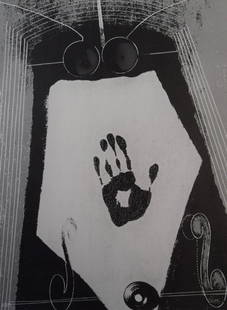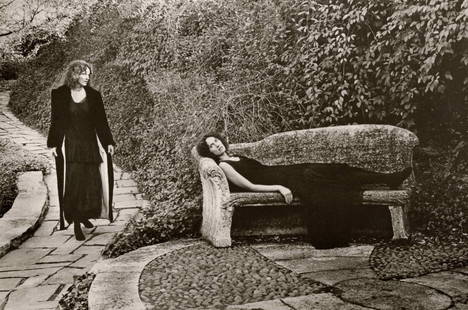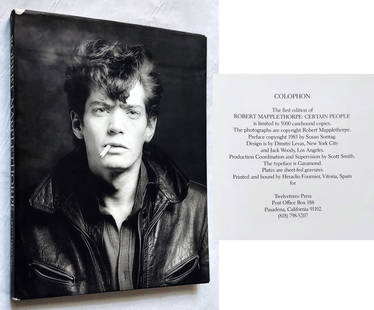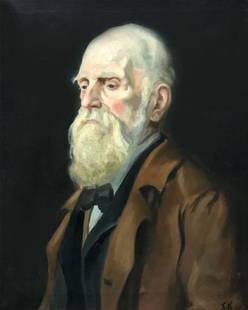
CURTIS SELF PORTRAIT & Sample Book of Gravures
Edward Sheriff Curtis Sale History
View Price Results for Edward Sheriff Curtis
Related Photography
More Items from Edward Sheriff Curtis
View MoreRecommended Art
View More


















Item Details
Description
JOHN ANDREW AND SON. Photogravure Printing Sample Book, c. 1915. 35 sample photogravure plates on various papers, including 3 by Edward Curtis: one portrait of Edward Curtis in his hat, In the Land of the Apsaroke from Volume 4 of The North American Indian and Signal Fire to the Mountain God.
Dimensions of Curtis photogravures:
Edward Curtis Portrait: 7.3x4.8" photogravure on 11.5x9" tissue paper.
In the Land of the Apsaroke: 7.3x3.3" photogravure on 11.5x9" tissue paper.
Signal Fire to the Mountain God: 7.3x5" photogravure on 11.5x9.3" Holland Van Gelder paper.
John Andrew & Son (est.1869) was an engraving firm in Boston, Massachusetts, established by John Andrew and his son George T. Andrew. A department of the Suffolk Engraving & Electrotyping Co., John Andrew & Son and Suffolk Engraving Co. produced all photogravures and copper plates for Edward Curtis' The North American Indian from 1906-1930.
Here is the short description included in this book of the photogravure process used by Curtis' printers:
Photogravure has been justly called the aristocracy of the photographic reproductive processes. It is an intaglio process having every advantage of photographic accuracy and the depth and richness of a steel engraving or an etching. It is printed in exactly the same manner as the latter, from a copper plate, the surface of which is protected with a delicate coating of steel. It must be borne in mind that it is exactly the opposite from relief or letterpress printing, inasmuch as the paper is squeezed into depressions in the plate, which are filled with ink, instead of taking the ink off of a surface which is covered with ink.
The process of plate-making is as follows: On a highly polished copper plate is deposited a very fine dust of bitumen, which is a resinous powder. This is subjected to a proper degree of heat which melts the fine particles of the powder to a certain extent, and gives a plate covered with a very fine resinous grain. This copper plate is then coated with sensitized gelatine in practically the same manner as a photographic dry plate is made. A regular toned negative, of the same nature as would be required to make a good print on photographic paper is made, and from this a positive of the size called for in the final photogravure print. This positive is of the same nature which we see in a window transparency or lantern slide.
The sensitized grained copper plate is then placed in contact with the positive in a printing frame and placed in the proper light, exactly as if we were making a photoÂgraphic print on paper. The action of the light on the sensitized grain on the copper hardens it in different degrees, according to the different tones of the positive. The highlights or transparent parts of the positive allow the strongest action of light, which hardens the particles of the grain protecting these parts of the plates to the greatest extent, so that when we come to etch the plate the acid has very little chance, or none at all, to disturb the surface of the copper. The shadows being acted upon less, or not at all, leaves the copper in different degrees of protection and gives the acid chance to bite into the copper to a greater or less extent, as called for in different values of shadows and blacks in the subject.
We must bear in mind all the time that this operation is exactly the opposite from that which we wish to obtain in a half-tone or a relief plate, as we wish the lights to be solid metal and the darks to be depressions in the metal, hence the use of a positive instead of a negative. When we get a proper print on the copper and have washed away the superfluous gelatine, we have a plate which is protected in varying degrees in accordance with tones of the subject.
The next step is to protect all the surface of the copper outside the boundaries of the picture, as this must be perfectly polished. This is painted over with an asphaltum varnish, as well as the back of the plate, and we are ready to etch. The etching is done with perchloride of iron solution as an acid and the result is the dependent on the skill and judgment of the etcher. The plate is then thoroughly cleaned, and we have in the darks of the picture a roughness of copper, but extremely fine in texture, and this roughness or grain smoothing itself out through the different tones until, when we get to where we wish white paper, we have no grain at all, but smooth polished copper.
Any defects are corrected, or minor changes are now brought about, in the same manner that a steel engraver or etcher would manipulate a steel or copper plate, and we are ready for a proof. The plate is put on the bed of the press, which is flat, and kept lightly heated, and the ink applied by hand roller in quantity sufficient to thoroughly fill all the interstices of the grain in the plate, and the excess wiped away with cloth and afterword with the bare hand. The paper which can be of almost any nature except coated or highly sized, is dampened and laid on the plate. The bed is then run under a roller covered with a woolen blanket, with considerable pressure, which squeezes the paper into the filled-in grain, and the result is a print which in depth of shadow and beautiful gradation, and softness of tone, cannot be equaled by any other photographic reproductive process.
As soon as this proof is considered approved, and we are ready to print the edition, the plate is electro-plated with a very thin coating of steel which in no way affects the quality of tones, but protects the delicate grain which would soon wear away, as the copper itself is too soft to stand the continued wiping and general wear of printing.
The impression of quality is heightened when the photogravure is printed on one of the many imported hand-made papers from Japan, Italy, France, Spain and England.
In presenting chis selection of reproductions by photogravure of a varied line of subjects, we desire to call to mention to the superiority of this process to any in existence at the present day for the reproducing of pictorial or commercial subjects.
Its place, as regards the reproduction of paintings and book illustrations, needs no comment, and its use, in presenting high-class goods to select lists of patrons, presents possibilities which can be readily appreciated from the samples shown in this booklet. Its distinctive quality suggests the same quality in the goods advertised.
The wide range of selection of paper and the method of printing ensure a result, in the final product, absolutely equal to the first finished proofs, with no falling off in quality as in half-tone or other mechanically printed reproductions. It is a process of plate-making and printing that at once lifts a piece of advertising matter out of the ordinary.
Dimensions of Curtis photogravures:
Edward Curtis Portrait: 7.3x4.8" photogravure on 11.5x9" tissue paper.
In the Land of the Apsaroke: 7.3x3.3" photogravure on 11.5x9" tissue paper.
Signal Fire to the Mountain God: 7.3x5" photogravure on 11.5x9.3" Holland Van Gelder paper.
John Andrew & Son (est.1869) was an engraving firm in Boston, Massachusetts, established by John Andrew and his son George T. Andrew. A department of the Suffolk Engraving & Electrotyping Co., John Andrew & Son and Suffolk Engraving Co. produced all photogravures and copper plates for Edward Curtis' The North American Indian from 1906-1930.
Here is the short description included in this book of the photogravure process used by Curtis' printers:
Photogravure has been justly called the aristocracy of the photographic reproductive processes. It is an intaglio process having every advantage of photographic accuracy and the depth and richness of a steel engraving or an etching. It is printed in exactly the same manner as the latter, from a copper plate, the surface of which is protected with a delicate coating of steel. It must be borne in mind that it is exactly the opposite from relief or letterpress printing, inasmuch as the paper is squeezed into depressions in the plate, which are filled with ink, instead of taking the ink off of a surface which is covered with ink.
The process of plate-making is as follows: On a highly polished copper plate is deposited a very fine dust of bitumen, which is a resinous powder. This is subjected to a proper degree of heat which melts the fine particles of the powder to a certain extent, and gives a plate covered with a very fine resinous grain. This copper plate is then coated with sensitized gelatine in practically the same manner as a photographic dry plate is made. A regular toned negative, of the same nature as would be required to make a good print on photographic paper is made, and from this a positive of the size called for in the final photogravure print. This positive is of the same nature which we see in a window transparency or lantern slide.
The sensitized grained copper plate is then placed in contact with the positive in a printing frame and placed in the proper light, exactly as if we were making a photoÂgraphic print on paper. The action of the light on the sensitized grain on the copper hardens it in different degrees, according to the different tones of the positive. The highlights or transparent parts of the positive allow the strongest action of light, which hardens the particles of the grain protecting these parts of the plates to the greatest extent, so that when we come to etch the plate the acid has very little chance, or none at all, to disturb the surface of the copper. The shadows being acted upon less, or not at all, leaves the copper in different degrees of protection and gives the acid chance to bite into the copper to a greater or less extent, as called for in different values of shadows and blacks in the subject.
We must bear in mind all the time that this operation is exactly the opposite from that which we wish to obtain in a half-tone or a relief plate, as we wish the lights to be solid metal and the darks to be depressions in the metal, hence the use of a positive instead of a negative. When we get a proper print on the copper and have washed away the superfluous gelatine, we have a plate which is protected in varying degrees in accordance with tones of the subject.
The next step is to protect all the surface of the copper outside the boundaries of the picture, as this must be perfectly polished. This is painted over with an asphaltum varnish, as well as the back of the plate, and we are ready to etch. The etching is done with perchloride of iron solution as an acid and the result is the dependent on the skill and judgment of the etcher. The plate is then thoroughly cleaned, and we have in the darks of the picture a roughness of copper, but extremely fine in texture, and this roughness or grain smoothing itself out through the different tones until, when we get to where we wish white paper, we have no grain at all, but smooth polished copper.
Any defects are corrected, or minor changes are now brought about, in the same manner that a steel engraver or etcher would manipulate a steel or copper plate, and we are ready for a proof. The plate is put on the bed of the press, which is flat, and kept lightly heated, and the ink applied by hand roller in quantity sufficient to thoroughly fill all the interstices of the grain in the plate, and the excess wiped away with cloth and afterword with the bare hand. The paper which can be of almost any nature except coated or highly sized, is dampened and laid on the plate. The bed is then run under a roller covered with a woolen blanket, with considerable pressure, which squeezes the paper into the filled-in grain, and the result is a print which in depth of shadow and beautiful gradation, and softness of tone, cannot be equaled by any other photographic reproductive process.
As soon as this proof is considered approved, and we are ready to print the edition, the plate is electro-plated with a very thin coating of steel which in no way affects the quality of tones, but protects the delicate grain which would soon wear away, as the copper itself is too soft to stand the continued wiping and general wear of printing.
The impression of quality is heightened when the photogravure is printed on one of the many imported hand-made papers from Japan, Italy, France, Spain and England.
In presenting chis selection of reproductions by photogravure of a varied line of subjects, we desire to call to mention to the superiority of this process to any in existence at the present day for the reproducing of pictorial or commercial subjects.
Its place, as regards the reproduction of paintings and book illustrations, needs no comment, and its use, in presenting high-class goods to select lists of patrons, presents possibilities which can be readily appreciated from the samples shown in this booklet. Its distinctive quality suggests the same quality in the goods advertised.
The wide range of selection of paper and the method of printing ensure a result, in the final product, absolutely equal to the first finished proofs, with no falling off in quality as in half-tone or other mechanically printed reproductions. It is a process of plate-making and printing that at once lifts a piece of advertising matter out of the ordinary.
Condition
Good. Curtis prints and first three pages are loose, cloth cover shows light wear and faded. Top of spine worn. One Curtis print, Nootka image is missing. Prints generally excellent, Curtis prints show some handling marks.
Buyer's Premium
- 28% up to $100,000.00
- 20% up to $1,000,000.00
- 18% above $1,000,000.00
CURTIS SELF PORTRAIT & Sample Book of Gravures
Estimate $2,000 - $3,000
15 bidders are watching this item.
Shipping & Pickup Options
Item located in Tucson, AZ, us$75 shipping in the US
Local Pickup Available
Payment
Accepts seamless payments through LiveAuctioneers

TOP











































































